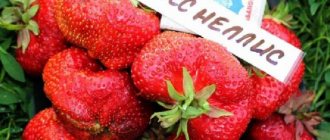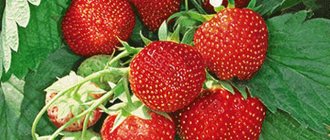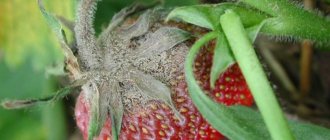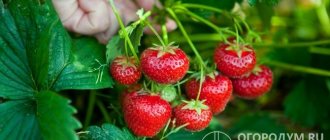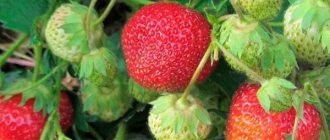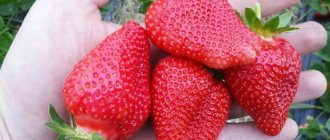The history of the origin of the Tsunaki strawberry variety is unknown. It is believed that this large-fruited berry was bred in Japan, although there is no mention of this name in Japanese gardening sources. The variety appeared in our country relatively recently, but thanks to its powerful bushes and large berries it is quickly gaining popularity.
Description of the variety
Tsunaki strawberries are distinguished by powerful bushes. In a fertile area, they reach half a meter in height and up to 60 cm in diameter, which is several times larger than the standard sizes characteristic of strawberries. Large leaves and powerful peduncles (up to a centimeter thick) protect the berries from the heat and prevent the fruits from bending to the ground. A powerful rosette of greenery that fades by winter can preserve bushes in winter without shelter, even in the conditions of the Urals and Siberia.
The berries are uneven, round or elongated, bright red. The sweet strawberry flavor is felt even when not fully ripe.
The Tsunaki variety is considered one of the largest-fruited. During the season, each bush produces up to 1.5-2.0 kg. juicy berries.
Tsunaki is a medium-late ripening variety that produces a harvest once per season. The first berries can reach 150 g. During the summer, the fruits become smaller.
Characteristics of the berry
It is one of the largest-fruited varieties and, with proper care, has the following characteristics:
- the berries are bright red in color with a glossy finish;
- the first ovary produces fruits that have a flattened comb-like shape and weigh about 130 grams; in subsequent rounded berries, the weight gradually decreases to 70 grams;
- the pulp of this variety is distinguished by its high juiciness, density, sweetness and strawberry-nutmeg aroma;
- During the growing season, you can harvest up to 2 kilograms from each bush.
Advantages and disadvantages of the variety
Unlike most large-fruited varieties, Tsunaki strawberries are dense and juicy, not losing their taste even in unfavorable weather. The long harvest period during the summer allows you to enjoy strawberries not only fresh, but also to prepare various preparations. Dense berries tolerate storage and transportation well. When frozen, strawberries retain a pleasant strawberry aroma with delicate notes of musk.
A large number of mustaches will make it easy to propagate the required number of seedlings. However, constant control over the spread of whiskers and removal of established rosettes takes quite a lot of time. Disadvantages also include a feature of almost every large-fruited variety - demanding fertilizing and labor-intensive care.
Even the light pink Tsunaki fruits have a sweet dessert taste.
Landing
Planting strawberries in a permanent place is possible in spring or autumn. Experienced gardeners advise giving preference to autumn planting, the main thing is to do it no later than a month before the first frost. The seedlings must have time to take root and prepare for winter.
Tsunaki strawberries are demanding on lighting and soil quality. It develops well and bears fruit in open sunny areas, protected from the wind. It is important that in winter the planting site is covered with a thick layer of snow.
It is the Japanese varieties of strawberries that are considered the largest-fruited and the most dessert.
Selection and preparation of a site
Like most varieties, Tsunaki strawberries will not bear fruit normally in areas with high acidity. The norm is a pH of no more than 6.5. A place with close groundwater is not recommended.
It is advisable that the bed be located at a slight slope of 5-10 degrees. This will avoid the accumulation of excess moisture during the spring melting of snow and when there is an abundance of precipitation. The slope should not be southern, otherwise early exposure of seedlings from under the snow may occur in the spring, increasing the risk of freezing of the above-ground part of the bush.
Be sure to remove all weeds when digging. Add rotted humus or compost. Peat acidifies the soil, so it should be used with caution. In areas with acidic soil, the addition of lime or other alkali is required. Strawberries grow well on black soil with a little sand added. When planting in sandy or loamy areas, it requires an increased dose of fertilizer.
How to choose seedlings
When purchasing young plants, attention should be paid primarily to the root system. Seedlings will take root well if their roots are at least 5 cm long. The seedling should have at least two or three true leaves. Any irregularities and colored specks on the leaf indicate a plant disease or degeneration of the variety. It is also better to discard a specimen with drying leaves.
Seedlings should be purchased only in specialized stores, where they will provide a certificate of conformity. Otherwise, there is a risk of buying a weak and non-viable plant or a mismatch.
Proper planting of strawberries
Tsunaki bushes are very large, so they require more free space than other representatives of this culture. The distance in the row between the bushes should be 60-100 cm. Between the rows - at least 1.0-1.5 meters.
It is better to land immediately according to all the rules, because Tsunaki does not require replanting for 5-6 years and the yield only increases with age.
It is recommended to adhere to the following disembarkation order:
- Dig up the area, remove the roots of weeds, and level the soil.
- Make shallow holes according to the diagram.
- Apply fertilizer to the hole and mix with loose soil.
- Fill the holes with water until a slurry (dirt) forms.
- When installing in a hole, straighten the roots of each seedling.
- Dig in so that the heart is slightly above the surface of the soil.
- Mulch the soil.
- Protect the planting from direct rays of the sun.
Tip: To ensure that the space between the strawberry bushes is not empty in the first years, you can plant winter garlic in the spaces between the rows. Garlic phytoncides will repel insect pests.
Tips for choosing seedlings
In the process of feeding berries, it is recommended to pay special attention to the root system. The seedlings will take root well in a new place if the root system is no more than 5 cm long. The number of leaves on the seedling should be 2-3 healthy units. In the process of selecting seedlings, it is important to pay attention to the external condition. Any external manifestations of disease indicate that Tsunaki will not produce a high-quality harvest.
Gardeners also recommend discarding seedlings with dry leaves. If there is any doubt about the quality of a product, the buyer has the right to request a certificate that will confirm the quality and legality of the sale of such a product. If the store refuses to provide certificates, you should not trust the nursery.
Planting care
Garden strawberries are a very finicky crop. With insufficient care, the berries quickly become smaller and the yield drops. Strawberries do not tolerate weeds nearby. Regular weeding will help avoid infection of the berry plant with fungus or other diseases.
Tip: Weeds crushed and placed in furrows between the rows will enrich the soil with useful components, have a positive effect on the quality of the crop, and act as mulch.
In early spring, it is necessary to inspect the plantings:
- Remove frozen and old shoots.
- Get rid of weeds.
- Loosen the soil around the bushes.
- Feed the planting with nitrogen fertilizers to increase green mass.
- If the soil is dry, water.
Watering
Water the seedlings daily for a couple of weeks after planting to improve survival rate. In the future, reduce watering to 1-2 times a week. In cloudy weather, you can water even less often. During the ripening period, strawberries are watered sparingly. It is important to avoid oversaturating the soil with moisture to prevent the development of diseases and mold.
Throughout the season, it is necessary to monitor the looseness of the soil around the bushes. Too compacted soil restricts air access to the roots and prevents plant development.
Feeding
In spring, strawberries require nitrogen fertilizers, which have a beneficial effect on the growth of green mass. You can use urea or infusion of mullein (1:10), chicken manure (1:20).
During the flowering period, Tsunaki can be fed with a solution of calcium nitrate or urea. When buds and ovaries appear, potassium nitrate is suitable for feeding. You can use complex drugs, for example, Agricola or Master.
Preparing for winter
Strawberries are prepared for the winter period depending on the weather conditions of a particular growing region. But there are also general rules:
- No later than mid-September, all old leaves are removed.
- The beds are covered with spruce branches or non-woven material.
In the southern regions of Russia, shelter is not required.
Diseases and pests
If the humidity regime is maintained, Tsunaki rarely gets sick. The strawberry mite can spoil the picture of resistance to diseases and pests. The drugs Actellik or Fufanon, which can be easily purchased at any gardening store, will help get rid of the pest. With thickened plantings and lack of mulch, gray rot may develop.
Reproduction
Tsunaki strawberries can be propagated by tendrils, seeds and dividing the bush.
If the method of propagation by mustache is chosen, then it is necessary to select several mother plants, from which all flower stalks are removed during the season, and the first order mustaches are spread in different directions from the bush and rooted in cups or soil.
It is more difficult to propagate strawberries using seeds. Sowing is carried out in January - February in mini-greenhouses. The seeds are very small and hard to germinate. Seed material is laid out in prepared loose, moist soil or peat tablets. Strawberries sprout in the light. It is strictly forbidden to cover the seeds with soil. When a pair of leaves appears, the seedlings are planted in separate pots, in which they will grow until planted in open ground. Strawberries obtained in this way begin to bear fruit no earlier than in the second or third year.
The division of the bush is carried out throughout the season. But the most favorable time is in the spring.
Mother plants must be mature and healthy. Plants 3-4 years old are suitable.
- Dig up the bush and shake it off the ground.
- Remove old center piece.
- Dip into water and divide into cones with one rosette of leaves.
- Plant it in a permanent place.
Additional Information
Tsunaki strawberries can be planted in open and closed ground . If possible, it is planted in a greenhouse, for example, made of polycarbonate. With proper care and optimal temperature conditions, you can enjoy delicious fruits not only in summer. They pollinate the plant on their own, removing pollen from the flower stalks with a brush.
Using a brush, they pollinate strawberries planted in a greenhouse.
In northern latitudes, covering material is often used , which helps protect the berries from prolonged frosty temperatures in winter (below 30 degrees below zero). Black spunbond is used as it. Agrofibre is suitable for all types of planting.
Reviews
Briefly about Tsunaki - the bushes are powerful, the peduncles and shoots with tendrils are as thick as a pencil, the leaves are huge, the berries are as big as frogs, hiding under the foliage. The taste is pleasant, dessert, even the pink berries are sweet. I came across a description where it is written that the maximum diameter of the berry is 12 cm, I don’t believe it, I have never grown such “apples” on strawberries.
I believe that the varieties: Favorite, Tsarevna, Kiss Nelis, Chamora, Tsunaki are all the same. I grew Favorite, Tsarevna and Tsunaki, well, exactly the same in taste and in the shape of the bushes and in terms of ripening.
Tsunaki's strawberry leaves conflicting feelings. Many gardeners are strongly behind it, and even more claim in their reviews that Tsunaki, Chamora Turusi, Kipcha are only marketing names for the same large-fruited variety. It will probably not be possible to find the truth, and what difference does it make what the variety is actually called, the main thing is that it is productive and tasty.
Strawberry Tsunaki
Among the many varieties of strawberries or garden strawberries, there are both domestically produced varieties and those that have foreign roots. Since the 90s of the last century, numerous imported varieties, mainly from Holland, Spain and Italy, have filled the berry market and have gained such popularity that often under their guise you can only find fakes that have nothing to do with the true varieties. But even many true varieties from Southern Europe and America are poorly adapted in terms of their growing conditions to the Russian climate. At best, the harvest obtained from them does not correspond to the declared characteristics. In the worst case, the plants simply freeze out or disappear for other reasons.
Strawberry seedlings from Japan behave somewhat differently, a country that, in many climatic characteristics, is much closer to Russia. All over the world, Japanese strawberries are considered the most large-fruited, and, most importantly, have outstanding taste characteristics. After all, large-sized berries are rarely truly sweet, and Japanese varieties have a truly dessert-like taste.
Tsunaki strawberries, a description of the variety and a photo of which you can find in the article, leave mostly rave reviews about themselves. However, there are still not very many people who grew it, since this variety appeared in the vastness of Russia relatively recently. Many even believe that such a variety does not exist at all, as well as the similar varieties Chamora Turusi, Kipcha, Kiss Nellis and others, presumably of Japanese selection.
